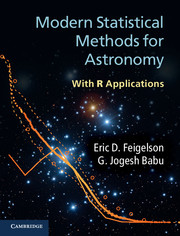Book contents
- Frontmatter
- Contents
- Preface
- 1 Introduction
- 2 Probability
- 3 Statistical inference
- 4 Probability distribution functions
- 5 Nonparametric statistics
- 6 Data smoothing: density estimation
- 7 Regression
- 8 Multivariate analysis
- 9 Clustering, classification and data mining
- 10 Nondetections: censored and truncated data
- 11 Time series analysis
- 12 Spatial point processes
- Appendix A Notation and acronyms
- Appendix B Getting started with R
- Appendix C Astronomical datasets
- References
- Subject index
- R and CRAN commands
- Plate section
7 - Regression
Published online by Cambridge University Press: 05 November 2012
- Frontmatter
- Contents
- Preface
- 1 Introduction
- 2 Probability
- 3 Statistical inference
- 4 Probability distribution functions
- 5 Nonparametric statistics
- 6 Data smoothing: density estimation
- 7 Regression
- 8 Multivariate analysis
- 9 Clustering, classification and data mining
- 10 Nondetections: censored and truncated data
- 11 Time series analysis
- 12 Spatial point processes
- Appendix A Notation and acronyms
- Appendix B Getting started with R
- Appendix C Astronomical datasets
- References
- Subject index
- R and CRAN commands
- Plate section
Summary
Astronomical context
Astronomers fit data both to simple phenomenological relationships and to complex non-linear models based on astrophysical understanding of the observed phenomenon. The first type often involves linear relationships, and is common in other fields such as social and biological sciences. Examples might include characterizing the Fundamental Plane of elliptical galaxies or the power-law index of solar flare energies. Astrophysicists may have some semi-quantitative explanations for these relationships, but they typically do not arise from a well-established astrophysical process.
But the second type of statistical modeling is not seen outside of the physical sciences. Here, providing the model family truly represents the underlying phenomenon, the fitted parameters give insights into sizes, masses, compositions, temperatures, geometries and other physical properties of astronomical objects. Examples of astrophysical modeling include:
Interpreting the spectrum of an accreting black hole such as a quasar. Is it a nonthermal power law, a sum of featureless blackbodies, and/or a thermal gas with atomic emission and absorption lines?
Interpreting the radial velocity variations of a large sample of solar-like stars. This can lead to discovery of orbiting systems such as binary stars and exoplanets, giving insights into star and planet formation. Is a star orbited by two planets or four planets?
Interpreting the spatial fluctuations in the Cosmic Microwave Background radiation. What are the best-fit combinations of baryonic, darkmatter and dark energy components? Are Big Bang models with quintessence or cosmic strings excluded?
The goals of astronomical modeling also differ from many applications in social science or industry.
Information
- Type
- Chapter
- Information
- Modern Statistical Methods for AstronomyWith R Applications, pp. 150 - 189Publisher: Cambridge University PressPrint publication year: 2012
